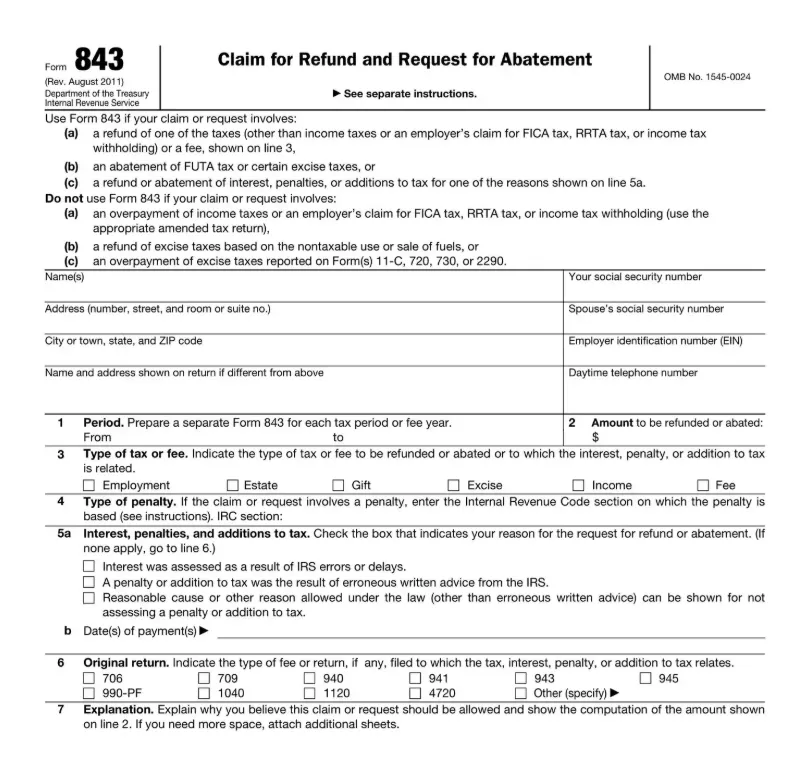Form 843: Key Takeaways
- Purpose – Use Form 843 to request a refund or abatement of certain IRS-assessed penalties, interest, fees, or specific non-income taxes.
- Eligibility Matters – It’s only for specific situations (e.g., IRS errors, reasonable cause penalties, excess Social Security tax from one employer).
- Strong Documentation – A clear written explanation and supporting evidence greatly improve approval chances.
- Deadlines Apply – File within 2 years of payment or 3 years from return filing, whichever is later, and mail to the correct IRS address.
When to File for IRS Form 843
You’d reach for Form 843 when:
- The IRS slapped you with interest or penalty by mistake.
- You paid a branded prescription drug fee or an annual health insurance provider fee, and you’re in the clear to request a refund
- You’re an employee who’s had excess Social Security, Medicare, or RRTA tax withheld by one employer, and that employer can’t (or won’t) fix the overcollection
- You’re facing fees or penalties tied to incorrect IRS advice, dyed fuel misuse, misstatements due to appraisals, or trust fund recovery—basically a list of very specific exemptions.
Don’t use Form 843 to fix an ordinary income tax return or to ask for a refile of FICA. That’s handled with other forms like Form 941‑X, etc.
Overview: Your Step-by-Step Journey to Filling Form 843
- Confirm eligibility: Does your situation match one of the acceptable reasons above?
- Gather your documentation:
- IRS notice (if one was issued), including section numbers for penalties you’re challenging.
- Records of payment or assessed penalties.
- Any supporting evidence: correspondences, receipts, medical records, legal advice or specific IRS guidance.
- Fill in the form:
- Personal and taxpayer details.
- Clearly check the box that matches your reason for filing.
- Craft a persuasive statement and attach documents.
- Sign and date properly:
- Joint filers must both sign.
- Corporations require an officer’s signature and title.
- Estates or trusts use a fiduciary signature.
- Submit it:
- Mail to the address specified on any IRS notice you received.
- If it's a branded drug fee, send it to the designated IRS address in Ogden, UT.
- Keep track of timing:
- File within two years from payment of tax or three years from filing the return, whichever is later.
- After filing:
- If the IRS denies your claim or doesn’t respond within six months, you can file a suit in U.S. District Court or U.S. Court of Federal Claims.
Form 843 Structure: Section-by-Section Breakdown
Let’s walk through the structure of Form 843—you’ll want to navigate with confidence and clarity.
Header: Boxes for Your Reason
Start strong—select the box that best explains your reason:
- Abatement/refund of non-income tax (excluding FICA, RRTA).
- Employee refund of excess Social Security, Medicare, or RRTA tax.
- Penalty abatement due to reasonable cause or IRS error.
- Specialty categories like dyed fuel misuse, branded prescription drug fee, or fees for health insurance providers.
1–3: Identification
- Line 1–3: Name, address, and taxpayer identification number (SSN or EIN depending on entity).
4: Penalty Section Number (if applicable)
- For penalty abatement, write the Internal Revenue Code section number of the penalty you're contesting (e.g., 6676, 6672
5a: Type of Request
- Tick the category (abatement, refund, interest, fee, etc.) that aligns with your situation.
6: Tax Period
- Identify the tax year or period relevant to your claim.
7: Explanation of Facts
- This is your stage. Write a detailed, factual narrative—explain exactly what happened, why it was erroneous or unfair, and what relief you’re seeking.
- Provide documentation such as IRS notices, timelines, third-party statements, or rationale (e.g., illness, reliance on incorrect advice).
- Be concise, yet vivid and clear in describing your cause.
Attachments
Include any relevant files, labeled and referenced in your explanation. Whether it’s a damaged receipt, a physician’s note, or a corrected affidavit—label clearly.
Signature Section
- Individuals/joint filers: Both spouses sign.
- Corporations: Must include officer title.
- Estates/Trusts: Fiduciary signature required.
Tips For Making Your Form 843 Submission Shine
- Match precision: State “Reasonable cause: [insert explanation]” and back it up with proof—doctor’s notes, weather delays, death certificates, legal counsel, or correspondence.
- Label everything: For complex cases, use 'Attachment A – IRS Notice dated MM/DD/YYYY' and reference it in your narrative.
- Stay within limits: Don't overexpand—let your core story shine. If possible, keep your statement to one or two well-crafted pages.
- Deadline savviness: If you're close to the limitation period but still building evidence, file a protective claim to preserve your right while gathering proofs.
- Follow‑up: Mark your calendar—if no reply in six months, you may escalate to court.
Filing Addresses & Logistics
- Use IRS notice instructions first: If you’ve received a notice, it usually tells you where to send your reply.
- Typical special case: For branded prescription drug fee refunds, mail to:
Internal Revenue Service
Mail Stop 4921 BPDF
1973 N. Rulon White Blvd.
Ogden, UT 84404
- Track your submission: Send via certified mail or priority post, keep copies and tracking info.
What to Expect Next
- Acknowledge receipt: The IRS may send a confirmation.
- Processing: Typically up to 6 months—during which they may ask for more information.
- Approval or denial: If accepted, you get a refund or abatement. If denied, you’re entitled to petition the courts.
Simplified Workflow at a Glance
| Step | Action |
|---|---|
| 1 | Confirm eligibility—match your case to IRS categories |
| 2 | Gather documentation—notice, proof, narrative |
| 3 | Complete form—precise checkboxes, explanation Included |
| 4 | Sign appropriately—joint, officer, or fiduciary per entity |
| 5 | Mail to the correct IRS address—special labels if needed |
| 6 | Keep records—tracking, copies, deadlines |
| 7 | Follow up if no response by 6 months |
| 8 | If denied, consider court petition |







Loading comments...